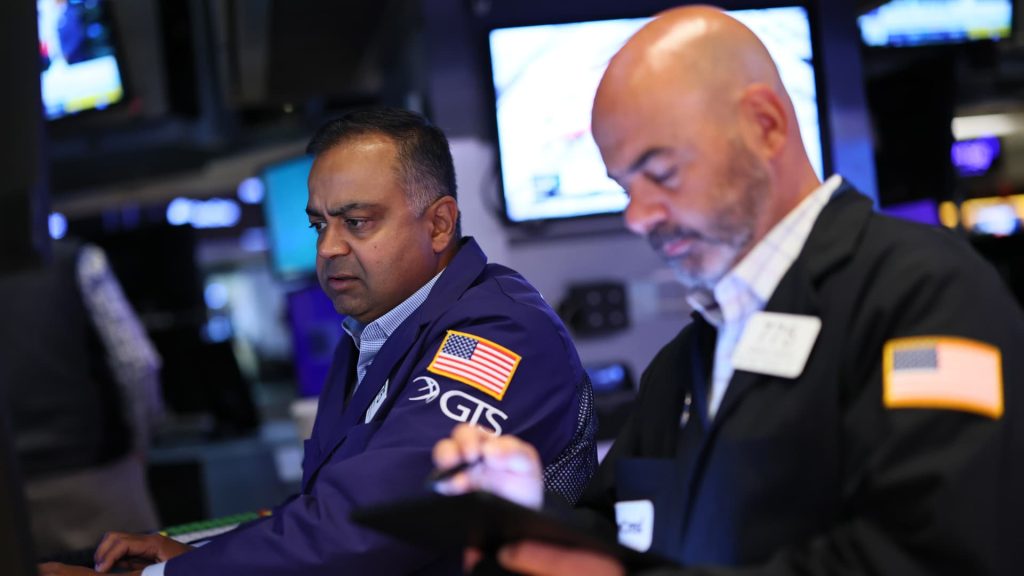Navigating a Tariff-Laden Market: Stocks React to Trump’s Trade Moves Amidst AI Optimism
Introduction:
The stock market is currently navigating a complex landscape, grappling with the potential ramifications of newly announced tariffs while simultaneously riding a wave of optimism fueled by advancements in artificial intelligence (AI). Following a period of losses driven by trade concerns, Wednesday’s trading session saw a rebound, with the S&P 500 and Dow Jones Industrial Average posting positive gains. However, the positive momentum was somewhat tempered by President Trump’s announcement of a 50% tariff on imports from Brazil, a move that has sparked debate and uncertainty about the future of global trade relations. This article delves into the recent market movements, the impact of the proposed tariffs, and the offsetting force of the AI boom, offering an analysis of the key factors shaping the current investment environment.
Stock Futures Hover as Market Digests Tariff News
In the aftermath of Wednesday’s trading session, stock futures remained relatively stable, indicating a cautious market sentiment. S&P 500 futures and Nasdaq 100 futures traded near the flatline, while futures tied to the Dow Jones Industrial Average dipped slightly, down by less than 0.1%. This subdued reaction suggests that investors are still assessing the potential consequences of the newly announced tariffs and their impact on the broader economy.
Trump’s Tariff on Brazil: A Retaliatory Move?
President Trump’s decision to impose a 50% tariff on imports from Brazil has injected a fresh dose of uncertainty into the global trade arena. The move, announced late Wednesday, was justified on two grounds: first, as a response to the ongoing trial against former Brazilian President Jair Bolsonaro, alleging his involvement in attempts to overturn the 2022 election results; and second, due to what Trump characterized as a “very unfair trade relationship” with Brazil.
This decision has drawn sharp criticism and raised concerns about the potential for retaliatory measures. Brazilian President Luiz Inacio Lula da Silva has already stated that Brazil will respond to the levy in accordance with its economic reciprocity law, setting the stage for a potential trade war between the two nations.
A Broader Tariff Offensive: Implications for Global Trade
The tariff on Brazil is not an isolated incident. President Trump has been actively pursuing a more protectionist trade policy, sending letters that dictate new U.S. rates on the imports of at least seven additional countries. Prior to this, similar letters were sent to the leaders of 14 other countries, including key economic partners like Japan and South Korea. These duties are scheduled to take effect on August 1st, adding further pressure to the global trade system.
The implications of these tariffs are far-reaching. They could lead to higher prices for consumers, disruptions in supply chains, and a decrease in global trade volumes. Furthermore, they risk provoking retaliatory measures from other countries, potentially escalating into a full-blown trade war.
Wall Street Rebounds Amidst AI Enthusiasm
Despite the concerns surrounding tariffs, Wall Street experienced a positive trading session on Wednesday, with the S&P 500 and Dow Jones Industrial Average posting their first gains in three sessions. The Nasdaq Composite, fueled by optimism surrounding artificial intelligence, jumped 0.9% and closed at a record high.
The AI sector has been a significant driver of market growth in recent months, with companies like Nvidia leading the charge. Nvidia’s shares surged nearly 2% on Wednesday, briefly propelling the company’s valuation to $4 trillion, making it the first public company to reach this milestone.
AI as a Counterbalance to Tariff Concerns
The bullish sentiment surrounding AI has provided a much-needed boost to the stock market, helping to offset some of the negative impacts of the tariff announcements. Jeremy Siegel, Wharton School professor of finance and Wisdom Tree chief economist, suggested that AI might be exactly what is needed to counteract any price increases resulting from the tariffs.
This perspective highlights the transformative potential of AI and its ability to drive economic growth, even in the face of trade-related challenges. However, it also raises questions about the sustainability of the AI boom and its ability to continuously offset the potentially detrimental effects of protectionist trade policies.
Federal Reserve Weighs Rate Cuts Amidst Economic Uncertainty
Adding another layer of complexity to the market outlook, the Federal Reserve’s June meeting minutes, released on Wednesday, revealed a division among policymakers regarding the number of interest rate cuts the central bank should implement in the coming months. Concerns over the potential impact of tariffs on inflation and the labor market were also discussed during the meeting.
The Fed’s cautious approach reflects the uncertainty surrounding the current economic environment. While the economy has shown resilience, there are concerns about the potential for a slowdown due to factors such as inflation, rising interest rates, and the impact of trade disputes.
Looking Ahead: Jobless Claims and Economic Data
Investors are closely monitoring economic data for clues about the health of the economy and the potential direction of monetary policy. Jobless claims data for the week ending July 5th is due out Thursday morning, with economists expecting a slight increase of 2,000 to 235,000 from the previous week.
This data point will provide further insights into the strength of the labor market and its potential impact on inflation and economic growth. Stronger-than-expected jobless claims could alleviate concerns about an economic slowdown, while weaker-than-expected data could fuel fears of a recession.
Analysis and Opinion
The current market environment is characterized by a tug-of-war between opposing forces. On one side, we have the potential negative impacts of protectionist trade policies, which could lead to higher prices, disrupted supply chains, and retaliatory measures. On the other side, we have the dynamism of the AI sector, which is driving innovation, boosting productivity, and attracting significant investment.
It remains to be seen which force will ultimately prevail. The impact of the tariffs will depend on the extent to which they are implemented and the degree to which other countries retaliate. The sustainability of the AI boom will depend on the continued pace of technological innovation and the ability of companies to monetize their AI investments.
In my opinion, while the AI sector holds immense promise and potential for long-term growth, it is unlikely to fully offset the negative impacts of a widespread trade war. Trade is the bedrock of modern global economics, and protectionist policies inevitably stifle innovation and reduce efficiency. While AI can potentially mitigate some of the inflationary pressures caused by tariffs through increased automation and productivity, the broader economic consequences of restricting trade, such as reduced consumer choice and market access for businesses, cannot be easily overcome.
Furthermore, the uncertainty surrounding the Fed’s monetary policy adds another layer of complexity to the investment landscape. A more hawkish stance by the Fed, characterized by fewer interest rate cuts, could further dampen economic growth and put downward pressure on stock prices.
Conclusion
The stock market is currently navigating a challenging environment, balancing the risks associated with trade protectionism against the opportunities presented by advancements in artificial intelligence. Investors should remain vigilant and closely monitor economic data, policy developments, and corporate earnings to make informed investment decisions. Diversification and a long-term investment horizon are crucial for navigating these uncertain times. While the potential for AI to boost the economy is significant, the potential disruptions caused by widespread tariffs should not be underestimated. A balanced approach that considers both the potential benefits of technological innovation and the risks of protectionist trade policies is essential for successful investing in the current market environment.





